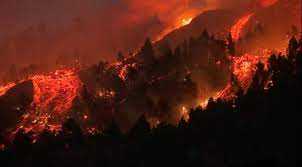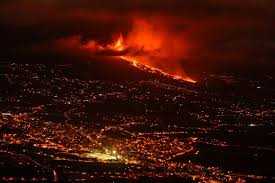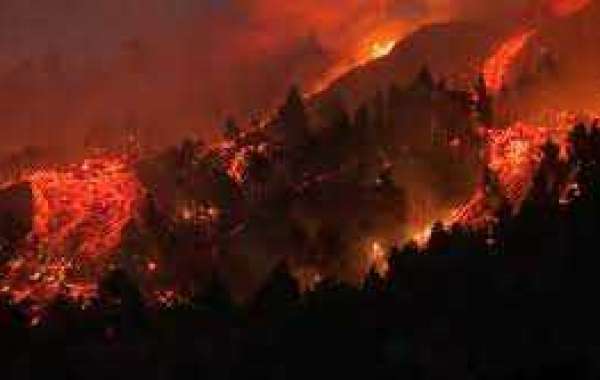click here to join the blue and red idea network's social media network
but the head of the regional government said Monday that he expected no injuries to people in the area after some 5,000 were evacuated. Lava was flowing on the island of La Palma toward the sea, moving at 2,300 feet per hour, according to the Canary Islands Volcanology Institute.

The lava was moving in two streams through a mostly unpopulated area, Canary Islands government chief Ángel Víctor Torres told SER radio. Some 20 isolated houses were destroyed, SER reported.
Mount Cumbre Vieja erupts in El Paso, spewing out columns of smoke, ash and lava as seen from Los Llanos de Aridane on the Canary island of La Palma on Sunday, September 19, 2021.DESIREE MARTIN/AFP VIA GETTY IMAGES
"We're not expecting any other eruption," Torres said, adding that air traffic in the area was not affected.
"There will be considerable material damage," he said. "We hope there won't be any personal injuries."
The eruption opened two fissures about 650 feet apart. Officials said the lava streams would likely merge before reaching the sea.
The lava crept into the town of Los Llanos de Aridane, which lies close to the volcano. Town Mayor Noelia García said people had been evacuated from houses all the way down to the shoreline.

Experts said the eruption could last for weeks or even months.
Lava flows behind houses following the eruption of a volcano in the Cumbre Vieja national park at Los Llanos de Aridane, on the Canary Island of La Palma, September 20, 2021.BORJA SUAREZ/REUTERS
People on La Palma largely live from farming.
Spanish Prime Minister Pedro Sánchez was due to visit the affected area Monday after canceling his trip to New York to attend the U.N. General Assembly.
The volcano erupted on Sunday after a weeklong buildup of seismic activity. The Canary Islands Volcanology Institute reported the initial eruption near the southern end of the island, which saw its last eruption in 1971.
Huge red plumes topped with black-and-white smoke shot out along the Cumbre Vieja volcanic ridge, which scientists had been closely watching following the accumulation of molten lava below the surface and days of small earthquakes.
Authorities had evacuated more than 5,000 people by Monday morning, but Spain's Civil Guard said the previous day that it could need to evacuate up to 10,000 residents in total.
A house burns due to lava from the eruption of a volcano in the Cumbre Vieja national park at Los Llanos de Aridane, on the Canary Island of La Palma, September 20, 2021.BORJA SUAREZ/REUTERS
La Palma, with a population of 85,000, is one of eight volcanic islands in Spain's Canary Islands archipelago off Africa's western coast. At their nearest point, the islands are 60 miles from Morocco.
A 4.2-magnitude quake was recorded before the volcanic eruption, which took place in an area known as Cabeza de Vaca on the western slope as the ridge descends to the coast. As the eruptions continued two open mouths belched bright red magma into the air that then flowed in tight streams down the mountain slope.
Carlota Martín was at an agricultural plot her family has in Todoque, just downhill from the eruption site, when she heard a huge explosion.
"When we saw the column of smoke, we thought it could not be real, but it kept growing and we knew we had to get out of there," she told The Associated Press. "You leave, but you are also looking back because you want to see what will happen. Nobody knows how the lava flows will descend, but our plot and lots of houses in the area could be in the way."
Smoke rises at the Cumbre Vieja volcano on the island of La Palma in the Canaries, Spain, on Sunday, September 19, 2021.JONATHAN RODRIGUEZ / AP
The last eruption on La Palma 50 years ago lasted just over three weeks. The last eruption on all the Canary Islands occurred underwater off the coast of El Hierro island in 2011. It lasted five months.
Volcanologist Vicente Soler of Spain's Higher Council said "the material appears to be very fluid, the lava flows will reach the sea sooner or later." The scientific committee of the Volcano Risk Prevention Plan said part of the island's southwest coast was at risk for landslides and rock falls.
click here to join the blue and red idea network's social media network








